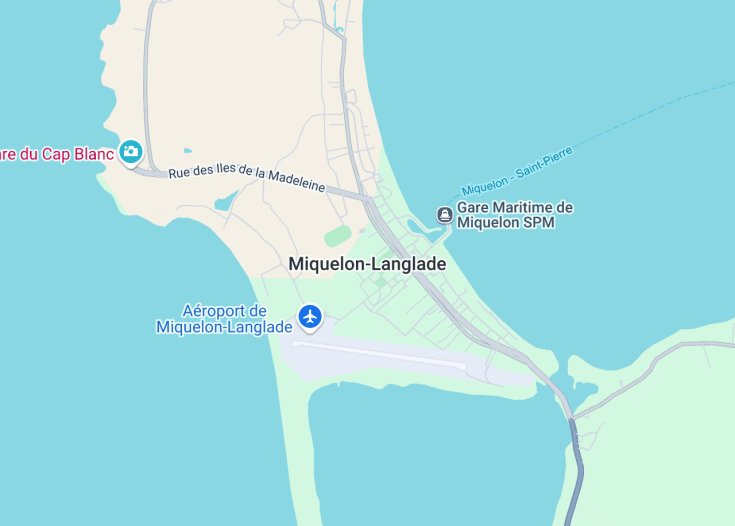Miquelon, part of the Saint Pierre and Miquelon archipelago, offers a distinctive blend of French and North American culture, set in the North Atlantic. This small island is characterized by its rugged coastal beauty, rich history, and the warm, welcoming nature of its community. Visitors can explore the dramatic landscapes, observe diverse wildlife, and indulge in culinary delights influenced by both French sophistication and local traditions. Miquelon is a haven for those seeking a quieter, more introspective travel experience away from the bustle of mainstream tourism.
Consider visiting during the summer months when the weather is most favorable, and the island’s flora is in full bloom, enhancing its scenic beauty.
Don’t miss a chance to visit the Miquelon Museum of Local Life & History to gain a deeper understanding of the island’s unique cultural heritage.
Top things to do & see in Miquelon
Select the following sights and activities to discover best tickets and tours available in Miquelon.
Discover Miquelon: A Hidden Gem in the North Atlantic
| Country | Saint Pierre and Miquelon (France) |
| Time in Miquelon | GMT-3 |
| Language spoken | French |
| Population | 600 (Source: Latest Census) |
| Currency | Euro (€, EUR) |
| Airports |
|
Located in the North Atlantic, Miquelon is an integral part of the French overseas collectivity known as Saint Pierre and Miquelon. This small island, part of an archipelago, lies south of Newfoundland, offering a picturesque escape with its rugged cliffs and rich biodiversity. Despite its small size, Miquelon has a unique cultural history as it has been a French territory since 1763, following the Treaty of Paris.
The population of Miquelon is predominantly of Basque and Norman descent, which influences the local customs and traditions. One can find a blend of French and local culture in the cuisine, festivals, and daily life of the people here. Miquelon also boasts significant ecological diversity, with its marine environment being especially noteworthy. Whales, seals, and seabirds are common sights, which makes the island a popular spot for wildlife enthusiasts.
Geographically, Miquelin is characterized by dramatic landscapes featuring steep hills, expansive wetlands, and a rocky coastline. The climate here is subarctic, typified by cold, snowy winters and cool summers, which adds to the island’s untouched, pristine allure. Not surprisingly, ecotourism is a growing attraction, with visitors coming to hike, bird-watch, and partake in other outdoor activities that allow them to connect with nature in a direct and impactful way.
Where is Miquelon?
Miquelon is located in the North Atlantic Ocean, immediately south of Newfoundland, Canada. This positioning gives it unique geographical and climatic characteristics.
Distances:
From Saint-Pierre to Miquelon:
| Route | Distance by boat | Time by boat |
| Saint-Pierre to Miquelon | 6 mi (10 km) | 1 hour |
What is Miquelon famous for?
Miquelon is renowned for its serene landscapes and vibrant wildlife. It’s a sanctuary for nature lovers, offering unspoiled natural beauty and the charm of a small, isolated community steeped in French culture.
History
Before 1600s: Native Land
Before European settlers arrived, Miquelon was primarily inhabited by Paleo-Eskimo peoples and later by the Beothuk tribe, known for their red ochre clothing. The rugged island provided abundant fishing resources and dense fog environments that were intrinsic to their lifestyle and survival techniques.
1600s-1763: European Colonization
The French were the first Europeans to show a sustained interest in Miquelon, leading to minor settlements primarily used as summer fishing camps. Throughout the 1600s, French and Basque fishermen exploited the rich cod stocks. In 1713, under the Treaty of Utrecht, France formally recognized British sovereignty over Newfoundland but retained rights, solidifying the foundations of future settlements on Miquelon.
1763-1816: Turbulence and Transition
Following the Treaty of Paris in 1763, the British took control of the islands, which resulted in sporadic occupation and frequent skirmishes. The French regained control in 1816, heralding a period of stability and growth for Miquelon’s development as a fishing enclave.
1816-Present: Growth and Modernity
From the mid-19th century, Miquelon emerged as a center of fishing and trade. During the Prohibition era in the United States, it famously became a smuggling hub. In contemporary times, it has positioned itself as a unique tourist destination within France’s overseas territories, maintaining its cultural heritage and pristine natural environments despite modern challenges.
Visit Miqueloni
What to see and do in Miquelon
Explore the natural beauty and rich history of Miquelon. Visit the Cap de Miquelon for stunning cliff views and bird watching. Take a historical tour of the island to learn about its intriguing past from its early native inhabitants to its role in international fishing industries. Venture on a hiking trail at Morne de la Grande Montagne for panoramic views. Don’t miss:
- The Miquelon Culture and Heritage Museum for local artifacts
- Annual Puffin Festival with guided nature walks
- Boat tours around the islands for seal and whale watching
Essential Events in Miquelon
Miquelon is home to vibrant cultural festivals. The most notable is the ‘Fête de la Mer,’ an annual maritime festival in July celebrating the island’s fishing heritage with boat races, seafood feasts, and live music. Winter brings the unique ‘Snow Crab Festival’ in March, offering culinary delights and winter sports activities.
Best time to visit Miquelon
The optimal time to visit Miquelon is during the summer months, from June to September, when the climate is milder, and outdoor activities such as hiking and wildlife viewing are most enjoyable.
is Miquelon worth visiting?
Miquelon, with its rich history, dramatic landscapes, and unique cultural festivals, offers a distinctive travel experience. While it might lack some of the amenities found in bigger tourist destinations and the weather can be unpredictable, its untouched natural beauty and the warmth of its small community make it a worthwhile visit for those seeking tranquility and a touch of adventure. Visitors should come prepared for a slower, more reflective type of vacation.










